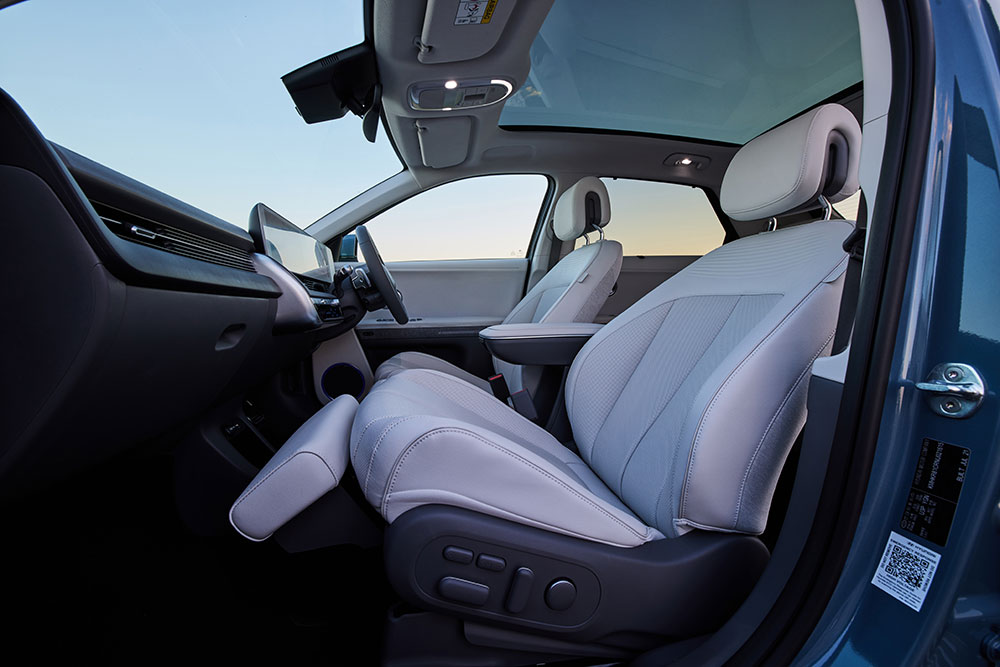Electric cars that come with extra space
Why purpose-built electric cars offer more interior space than retrofitted models.

With an increasing number of new electric cars coming to market an additional benefit of these new-age vehicles is the fact many are designed to offer more interior space and legroom.
There are currently two main types of electric cars being manufactured – those based on an existing internal combustion engine (ICE) vehicle and retrofitted to an electric powertrain, such as the Hyundai Kona EV, and those that are a ground-up EV designs based on a dedicated ‘skateboard’ platform, such as the Hyundai Ioniq 5.
The skateboard platform is a flat chassis with four wheels that accommodates the traction battery and electric motors. This design has several advantages for the vehicle operator.
First, having the battery pack down low means a lower centre of gravity, which equates to better vehicle dynamics (handling).
Second, being specifically designed to accommodate the EV traction battery and driveline frees up more space for passengers.
This is noticeable in the lack of a transmission tunnel running down the centre of the vehicle, meaning greater cabin space, particularly for the middle-rear passenger.
The absence of a combustion engine and related components also means the cabin of a dedicated EV can be moved further forward and stretched during the design phase, creating a larger interior space in a vehicle that has the same exterior dimensions as an ICE vehicle.
A third benefit of a skateboard chassis is it can be used for several different vehicles with just the upper body panels, or ‘top hat’, changing for different models, thus reducing development costs.
A skateboard platform can also be easily modified if a manufacturer wants to offer a front-wheel-drive, a rear-wheel drive, or an all-wheel drive model, again saving time and money in development.
Another manufacturing upside of the skateboard platform is the chassis and body can be assembled separately and then combined towards the end of the build.
All these benefits are important in making EVs cheaper to manufacture and to improving their affordability, which is one of the key challenges to achieving greater EV take-up.
Related topics
Things to note
The information in this article has been prepared for general information purposes only and is not intended as legal advice or specific advice to any particular person. Any advice contained in the document is general advice, not intended as legal advice or professional advice and does not take into account any person’s particular circumstances. Before acting on anything based on this advice you should consider its appropriateness to you, having regard to your objectives and needs.
Insurance Products (excluding Travel Insurance) are issued by RACQ Insurance Limited ABN 50 009 704 152 (RACQI) and arranged by its agent, RACQ Distribution Services Pty Ltd (RDS) ABN 35 116 361 650, AFSL 567130 and RDS' authorised representatives (including RACQ Operations Pty Ltd ABN 80 009 663 414, AR No. 234978 (RACQO). Conditions, limits and exclusions apply. RDS and RACQO are in the RACQ group of companies. One of the companies in the RACQ group of companies has a minority shareholding in RACQI.
RDS and RACQO have not taken your personal objectives, circumstances or needs into account when preparing advice regarding insurance products and you will need to consider whether the advice is appropriate for you. Read the Product Disclosure Statement (PDS) and any applicable Supplementary PDS before making a purchase decision on this product. You can also access our Target Market Determinations on this website. RDS receives a commission from RACQI for the policies it arranges. RACQO receives fees paid for services it provides to RDS. Further details about remuneration are available on request prior to purchasing.
Banking and loan products issued by Members Banking Group Limited ABN 83 087 651 054 AFSL/Australian credit licence 241195 trading as RACQ Bank. Terms, conditions, fees, charges and lending policies apply. This is general advice only and may not be right for you. This information does not take your personal objectives, circumstances or needs into account. Read the disclosure documents for your selected product or service, including the Financial Services Guide and the Terms and Conditions, and consider if appropriate for you before deciding.
Except for RACQ Bank, any RACQ entity referred to on this page is not an authorised deposit-taking institution for the purposes of the Banking Act 1959 (Cth). That entity’s obligations do not represent deposits or other liabilities of RACQ Bank. RACQ Bank does not guarantee or otherwise provide assurance in respect of the obligations of that entity, unless noted otherwise.
RACQ Bank subscribes to the Customer Owned Banking Code of Practice which establishes higher standards than the law requires. The Code reflects modern consumer expectations and developments in approaches to issues such as consumer vulnerability, guarantors, and supporting customers through financial hardship. Please read our Customer Owned Banking Code of Practice page for more information.
RACQ Operations Pty Ltd (ABN 80 009 663 414 AR 000234978) and Members Travel Group Pty Ltd (ABN 45 144 538 803 AR 000432492) are acting as an Authorised Representative of the issuer of the insurance, Tokio Marine & Nichido Fire Insurance Co., Ltd. (ABN 80 000 438 291 AFSL 246 548). Any advice set out above is general in nature only, and does not take into account your objectives, financial situation or needs. Before purchasing any travel products, please consider the RACQ Travel Insurance Product Disclosure Statement (PDS) and the Target Market Determinations (TMDs) that apply to these products. Whilst the PDS outlines the Terms and Conditions of these products, the TMDs outline the intended class of customers that comprise the target market for these travel products. This will allow you to consider which products best suit your objectives, financial situation and needs and consider the products appropriateness to your personal circumstances. TMDs also outline matters involving the distribution and the review of these products. The PDS, Supplementary PDS and TMDs for each travel product can be found here.

